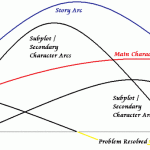Let’s talk about storyboarding. Another technique borrowed from the film industry, mapping out your story in a linear way can help identify plot redundancies, holes or scenes which are either in the wrong spot or need to be axed because they don’t move the story.
Writing Tip for Today: A good storyboard contains only the main plot points of the novel. These plot points can follow the shape of a classic story arc, with Inciting Incident, Complications, More Complications, Climax and Resolution being the primary destinations. Search your work-in-progress (WIP) and try to identify the scene where each of these plot points (also known as turning points) occurs.
· Inciting Incident. Most novels begin just before this event. This is known as Ordinary Time. When plotting out the Inciting Incident, “A” on the story Arc, watch for too much ordinary time, too much back story, or not enough action to propel us on the journey. Remember the ideas of beginning in “media res,” and that of the red wine about to hit the lady’s white satin gown.
· Complication. On the classic story arc, this is “B” or when “things get worse.” Often this is the first clash between the narrator or hero and the obstacle or antagonist. The character’s inner conflict becomes more evident, and subplots may be introduced. Watch for too many subplots, your hero winning too easily or too much and too much introspection—slows down the main action. A bit of back story might occur, but be careful not to leave your reader in the past too much.
· Complication 2. You’ll probably have several complications, two steps forward for one step back, scenes where the character thinks she’s conquered but then the obstacle pops up again. Identify this place in your story by choosing the occurrence with the highest stakes for the protagonist. Where does she have the most to lose, aside from the climax?
· Climax. This is always the ultimate do or die scene. If you think you need more than one climax, examine each for: inner/outer conflicts, how much “help” the protagonist receives, and of course whether he wins or loses. One potential problem is when the author uses the climax for the novel’s opening. You should save the most dramatic moments for the climax—and if you show us some of this scene in the opening (what is known as a bookend construction) don’t give everything away. Save the highest tension, drama and stakes for last. When storyboarding, this scene should come very near the end.
· Resolution. Here’s where you must “round up all the horses,” or tie up loose ends of the subplots and point your character in some direction. We must know if your protagonist is happy, sad or what. Or what is usually not advised.
NEXT: How to fix an ailing storyboard.





Linda, I appreciate the writing helps that you share. Hope that you compile them all into a book at some point! Blessings, Rita
Thanks, Rita. Keep writing! ~Linda
Linda, I am giving you The Tell Me About Yourself Blog Award!
You can read all about it in my post on Thursday, November 17. Don’t worry, if you don’t have time to participate, that’s A-OK with me, but if you’d like to participate, here are the rules:
Thank the person who awarded you, blog about it, list seven things about yourself, and list 15 other blogs you would like to pass the award on to.
Blessings!